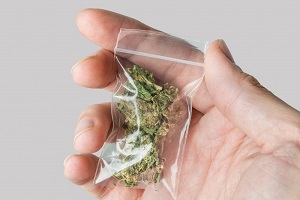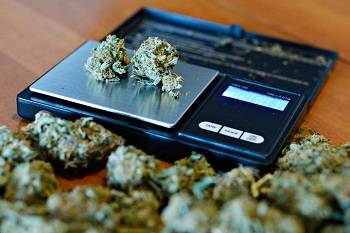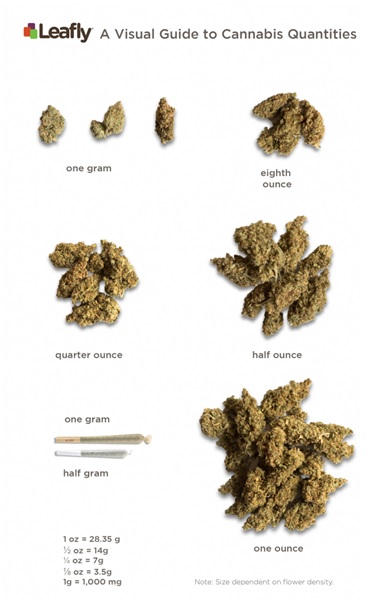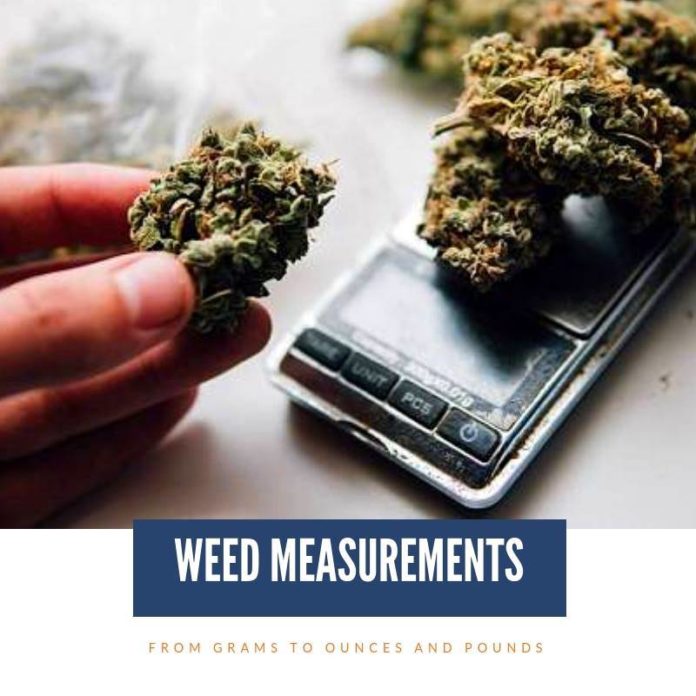Times are changing fast when it comes to the legalities of weed. In 2018, Canada approved recreational marijuana nationwide, and there is talk that Mexico will follow them.
In the United States, many states allow recreational use and others have legalized medicinal cannabis. With the evolving attitude, dispensaries are springing up everywhere that sell a wide array of products in an almost old-fashioned apothecary setting.
If you are a newbie to purchasing marijuana, then you are probably wondering, what are the forms of weed measurement?
Honestly, weed measurements are confusing. They are a combination of the metric system with the old-school Imperial measurements.
You will hear people saying grams, ounces, halves, and eighths. You might even feel a bit intimidated when you walk into a marijuana dispensary for the first time if you are unsure of the various measurements and terms.
You may be left wondering how much you can truly expect to purchase. Yes, your local budtender who is manning the dispensary counter will be happy to simply sell you cannabis based on how much money you have.
But it helps if you have a basic understanding of the various metrics that go into weed measurements, so you can make an economical purchase that provides you with the exact amount of marijuana products you desire and need. Making an educated decision is a lot less stressful than just guessing about things.
From Grams To Ounces – Low, Medium, High
Please take a few moments to look over this easy to understand chart that clearly gives you an idea of the grams vs ounces equivalents. The metric system and the imperial system often confuses many people.
Familiarizing yourself with this chart is a great way to get started on grasping weed quantities, and then you can move on to learning about the slang and history.
You can even print up this small graph to carry with you to the dispensary. Think of it as a ‘cheat’ sheet that you probably wished you had in high school math class!
Understanding from ounces to pounds to grams in dry weight measurements:
| Ounces | Pounds | Grams |
| 1 ounce | 1/16 of a pound | 28.3495 grams |
| 2 ounces | ⅛ of a pound | 56.669 grams |
| 3 ounces | ⅕.3 of a pound | 85.049 grams |
| 4 ounces | ¼ of a pound | 113.398 grams |
| 8 ounces | ½ of a pound | 226.796 grams |
| 16 ounces | 1 pound | 453.592 grams |
| 32 ounces | 2 pounds | 907.185 grams |
| 1 kilogram | 2.2 pounds | 1000 grams |
The Slang Of Weed
The colorful phrases of the subculture of the marijuana movement are so diverse that an entire pamphlet could be written about the various phrases and their history.
Since prohibition in the 1930s, words like reefer, locoweed, ganja, and Mary Jane have been bantered around. Modern terms like 420 are believed to have been inspired by the rock band Grateful Dead and a group of Northern California teens who used to leave school at 4:20 to head into the woods to get high.
Now, in honor of the phrase, April 20th has become ‘Weed Day.’ Another modern term is 710, which refers to ‘oil’ and is used for cannabis concentrate. The code number has now inspired National Dab Day every year on July 10.
Despite the exceptionally long and diverse history of weed slang, the standard and popular terms for weed measurements remain unchanged throughout the years. Once you learn the basics, you will be ready to enter a dispensary and make your purchase.
Now that you have an essential reference guide for the dry weight measurements of weed in ounces, pounds, and grams, it is time to explore basic street slang for marijuana weight that is still used today.
This can get a bit confusing, but this is the jargon that most weed buyers use when they enter a marijuana dispensary and decide to purchase weed by weight.
| Metrics | Common Weed Slang |
| 1 gram | 1 gram |
| 3.5 grams | ⅛ of an ounce (referred to as an eighth) |
| 7 grams | ¼ of an ounce (referred to as a quarter) |
| 14 grams | ½ of an ounce |
| 20 grams | 1 ounce (referred to simply as an ounce) |
| 448 grams | 1 pound (referred to as a pound) |
A One Gram Dime Bag

The weed street term ‘dime bag’ has been around for decades. Historically, ‘dime bag’ referred to half a gram of cannabis that was wrapped in a tiny plastic bag or tin foil.
On rare occasions, it was also purchased as a couple of joints that measured out to half a gram of weed tightly wrapped in rolling paper.
Years ago, a half a gram of marijuana cost $10 and so was referred to as a simple ‘dime bag.’ However, today that is no longer true. The half is now replaced with a full gram.
In a marijuana dispensary, the price of cannabis is graded by the quality of the plant being sold. You can no longer purchase half a gram of top-shelf marijuana for $10. If you tell the budtender you want a dime of weed, then you will receive $10 worth of marijuana, but there is no guarantee that you will be getting half a gram.
Depending on where you are located, a full gram (the lowest) can average up to $15-$20 and often goes even higher for a premium strain. Even marijuana is a victim of inflation so you can expect the prices to continue to change.
Jump From Grams To An Eighth Of An Ounce
You might be wondering what the most common amount of marijuana sold at a dispensary is? Without trouble, it is an eighth of an ounce.
Traditionally, an eighth of an ounce of marijuana has been a popular requested weight even when purchasing from your local dealer back in the dark days of illegal marijuana. Referred to just as ‘an eighth,’ it means an eighth of an ounce of weed which is approximately three and a half grams.
It will take most modest recreational smokers one to two weeks to smoke an eighth of marijuana. Dispensaries often charge from $20 to $60 per eighth depending on the marijuana’s quality and strain.
Now, how much plant material do you actually get with an eighth? You will receive enough for a couple of blunts or a handful of joints. An eighth is also often referred to as a ‘slice’ or a ‘half a quarter.’ Typically, it is enough to enjoy for a weekend with a friend or two.
Move Up: Grams To A Quarter Of An Ounce
If you don’t want to visit the dispensary for a while or you are planning a serious party, then you are going to want to purchase a quarter of an ounce which is enough weed to roll five to seven blunts or an entire box of joints.
A quarter is a traditional cannabis amount. It refers to a quarter of an ounce which is precisely twice as much as an eighth. It weighs out at seven grams.
Most regular marijuana smokers adore a quarter of an ounce. Prices for a quarter range from $30 to $60 depending on the quality of bud.
The Middle Half Of An Ounce To An Almighty Ounce Of Bud
An ounce is the highest amount of cannabis sold at a dispensary. It equals 28 grams. The middle of an ounce is 14 grams. Sure, you can ask for half an ounce of weed, or you can just purchase a full ounce.
Many weed smokers opt to buy an ounce of bud, so they do not make a lot of trips to a dispensary and because buying in bulk is often a tad bit cheaper.
Buying a ‘half’ at a dispensary starts to save you money because you are buying in bulk (and who doesn’t like to save?).
Depending on what dispensary and grade of bud you purchase, you are going to pay from $90 to $200 for a half. The average price hovers at just around $130, which is a reasonably good deal.
Most states and Canada have put a cap on how much marijuana you can purchase at once, and that is typically the ounce (28 grams). The almighty ounce in the weed world is really the base measurement for all marijuana products.
Everything breaks down from the ounce. The price of an ounce of decent quality weed ranges from $230 to $300.
However, if you really want to pinch your pennies, then you can buy an ounce of cheaper bud for only $200.
If you are wondering why on Earth you would want to purchase so much marijuana at once, well most people enjoy stocking up on their favorite strains, or they simply don’t like visiting a dispensary very often.
Scales For Weed

Obviously, a dispensary has top-of-the-line weed scales that are sufficiently accurate. They take the guesswork out of trying to determine if you are indeed purchasing a precise amount. However, some individuals have their own scales for weed.
There are innumerable types and brands of scales used to measure marijuana weight. However, whichever kind of scale that you decide to purchase should have the following:
- Accuracy: Remember that a high quality calibrated digital scale for weed should be within +/- one unit of its lowest display resolution.
- Precision: Precision is repeatability. Each time you measure the same bag of weed, the scale should always give identical measurements when weighed under the exact same conditions. The scale should never vary in weight.
- Readability: A digital display scale that offers clear readability.
- Maximum capacity: Many scales will have a 1,000-gram capacity and others will only read up to 20-grams. You will need to determine which size scale works best for your unique needs.
The Heavy Bags
Among frequent marijuana users, the term ‘heavy bags’ usually refers to a bag of weed that weighs a small amount more than it is supposed to weigh. It is often common for friends to provide each other with a pinch more as a good gesture. Many people also refer to the practice as a ‘hook it up.’
If you are buying bud from a dispensary, don’t expect to walk away with a heavy bag without paying for the additional weed. Let’s face the facts, a dispensary is a business, and they aren’t interested in hooking you up with an additional product unless they are having a sale.
Your local budtender is an all about accurate measurements and set prices. You won’t be getting a ‘pinch’ more from such a location.
Here are a few examples of heavy bags:
- An eighth would weigh out at 3.6 grams
- A quarter would weigh out at 7.2 grams
- A half would weigh out at 14.4 gram
- An ounce would weigh out at 28.8 gram
Of course, these are just examples. Some friends might be far more generous, and others could be skimpy.
Many people use a digital gram scale to measure out a heavy bag, and others go with the old-fashioned pinch which is an extra fingered pinch of the product placed into the bag.
A pinch is not scientific and is far from accurate, but an experienced cannabis user usually becomes precise entirely in their guess.
From Grams To A Quarter Pound
When you talk about weed and measurements, you might notice that the smallest metrics are denoted in the metric system (grams), but the larger metrics slowly transition into the imperial system of measurement (ounces and pounds). This can be very confusing for some people, but this has always been the unique dynamics of weed measurements.
Known as a ‘QP’ a quarter of the pound is not something you hear much about with the legalization in so many areas of recreational marijuana. The QP used to be popular among drug dealers. A quarter of pound works out to 112 grams (4 ounces).
In regions where weed remains illegal, the street price of a quarter of a pound of just average bud hovers at around $450 and goes up in price depending on the grade.
With the legalization of recreational marijuana, you are probably not going to hear the term QP much anymore. It is not something you will ever ask for in a dispensary.
Grams To A Half Pound Of Weed
Most weed smokers will purchase grams to a half pound of weed. Only hardcore users or individuals who want to avoid shopping frequently tend to purchase more than half a pound of pot.
In the old days, before legalization in Canada and numerous states, most law enforcement authorities viewed anything more than half a pound as enough to show intent to sell.
Grams to a half pound weighs 224 grams, and that is equal to 8 ounces in a half pound of weed. You can expect a $1000 to $1500 cost for a half pound of marijuana.
A Full Pound Of Weed On A Scale
Years ago, a full pound of weed on the scale was not 448 grams, but an actual pound is just slightly under 454 grams (453.592 grams).
However, if are a dispensary purchasing a pound of weed then you will receive 448 grams instead of 454 grams.
Grams To A Kilo Bag Of Weed
One kilo bag of weed equals 1000 grams. It is the largest amount of pot that you can purchase, and it is twice the weight of a single pound. Dispensaries and medical marijuana suppliers usually only obtain such a large quantity.
Most states allow a consumer only to purchase an ounce of marijuana at a time, so unless you are a black-market drug dealer, or you own a dispensary, you won’t be dealing with a kilo of marijuana.
Most Common Weed Measurements Over The World
These are the most common weed measurements in the world of marijuana that you will need to familiarize yourself with when purchasing a cannabis product from a dispensary.
- Gram AKA “Dime Bag”: A dime bag is not a full gram of weed. It is only half a gram. It is ridiculously hard to find any dispensary willing to sell you a dime bag (half a gram). However, many will sell you a whole gram. However, with the constantly fluctuating and rising cost of marijuana, it is going to be hard to find even half a gram for $10, much less a full ‘gram.’ In the old days, a dime bag was often just shaken which is less than ideal marijuana products. Dispensaries sell quality and top-quality cannabis strains so the price will typically be more than $10, depending on what you buy. The current average for half a gram is $18-$20 for half a gram.
- An Eighth: This is the next highest metric of weed sold. After this number, the measurements start to transition to the imperial system of measurement. An eighth of weed is an eighth of an ounce or three and a half grams of marijuana.
- A Quarter: A quarter is a quarter of an ounce of marijuana. This is twice the amount of an eighth and works out to about seven grams of cannabis.
- A Half: A half is a half of an ounce. This number is twice as much as a quarter and works out to eight grams of marijuana.
- An Ounce: An ounce is one ounce of cannabis. It is twice as much as a half and is equal to 28 grams.
How Does Grams Of Weed Look Like?
For many people, mathematics is hard to grasp and envision in real life. You are probably wondering exactly what the various measurements of weed really look like and how much you will be receiving.
| Street Measurement | Metric Equivalent | Comparable to: |
| 1 gram | 1 gram | 1 grape |
| ⅛ oz. (eighth) | 3.5 grams | 1 kiwi fruit |
| ¼ oz. (quarter) | 7 grams | 1 apple |
| ½ oz | 14 grams | 1 grapefruit |
| 1 ounce (ounce) | 28 grams | 1 coconut |
| 1 pound (16 ounces) | 448 grams | 1 watermelon |

Measuring Weed by THC Content
Now you have a good understanding of weed measurements so you can walk into any dispensary and ask for how much marijuana you want to purchase without feeling like a newbie. However, there is one final way that cannabis is measured which does not focus on weight.
Weed is now measured by its tetrahydrocannabinol (THC) content. THC is the psychoactive cannabinoid found in marijuana. It provides the user with a euphoric and relaxed feeling.
THC in cannabis is measured as a percentage. It refers to how much THC the plant contains versus the other cannabinoids. Nowadays, average strains of marijuana have 15 to 30 percent THC. More potent strains are also available.
Cannabis Concentrates And THC Levels
Cannabis concentrates are known for their prominent levels of THC. Products such as wax, shatter, and nug run often contains levels of around 80 percent THC.
A gram of concentrate that includes 80 percent THC will be labeled as an 80mg THC cannabis concentrate product. Concentrates are usually not for novice marijuana users.
A concentrated product with a prominent level of THC is exceptionally potent and fast acting compared to marijuana plant material or edibles.
THC In Edibles
The THC in edibles is provided as a milligrams dose. The average dose of THC in most edibles is 10mg. Concentrates work much faster on a user, but an edible’s effects will last much longer.
CBD Levels In Cannabis
Many people seeking medical benefits from marijuana opt to either purchase a straight CBD (cannabidiol) product that contains less than 0.3 percent THC or they choose to buy a strain of marijuana that is CBD dominate. This means that the percentage of CBD will surpass the levels of THC.
Interestingly, CBD also eliminates or reduces the psychoactive effects of THC, so if you purchase a CBD dominate strain, you will not experience any ‘high’ from the THC.
Times are changing fast, and cannabis is becoming mainstream. It is no longer something you sneak down a dark street to buy. With medical and recreational marijuana getting commonplace, many people are seeking to understand the various forms of weed measurement before making a purchase.
If you have any questions, most budtenders in the various dispensaries are incredibly knowledgeable and will happily take the time to walk you through the measurements plus the THC/CBD content of the multiple marijuana products and cannabis concentrates that they sell.
Rate This Article
[ratings]


















